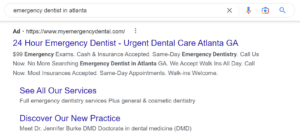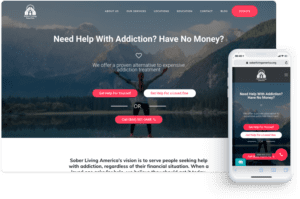If the current economic climate is giving you déjà vu, you’re not alone. Just as inflation seemed to be cooling off, it’s threatening to rear its head again. Consumer confidence is slipping, budgets are tightening, and healthcare providers are back in familiar territory—bracing for what could be another recession.
To make matters more complex, policy changes under the new Trump administration are already underway. Proposed cuts to Medicaid and Medicare, looming tariffs on medical supplies, and funding rollbacks for public health institutions are creating fresh uncertainty for healthcare organizations across the country.
That said, we’re not yet seeing widespread negative impact across our client roster. The effects will vary—largely determined by your payor mix, specialty, and reliance on government funding.
Marketing budgets, however, are often the first on the chopping block. But cutting without a plan can jeopardize growth and your competitive edge. Instead, smart marketers are responding with precision: aligning closely with business strategy, investing where demand and capacity intersect, and finding new ways to stretch every dollar.
In this article, we’ll explore how to adapt your healthcare marketing strategy for today’s economic climate, so you can keep growing, even when the market stalls.
How Economic Downturns Impact Healthcare
For years, healthcare was considered “recession-proof”—a non-negotiable expense backed by insurance, relatively insulated from economic turbulence. But that myth has been steadily unraveling.
The past two years of persistent inflation have pushed more cost-conscious behavior across the board. While inflation briefly cooled, it’s now threatening to rise again with economic growth stalling. This combination, known as stagflation, creates a uniquely challenging environment: consumer budgets are stretched thin, confidence is low, and healthcare decisions are increasingly scrutinized. Paired with high-deductible health plans and rising out-of-pocket costs, patients may treat healthcare more like a discretionary purchase and delay or forgo care when money is tight.
This consumer mindset shift leads to a cooling of demand, even for services once considered essential. Recessions only compound the issue by increasing unemployment and reducing access to employer-sponsored insurance, creating a growing population of underinsured and uninsured individuals.
Need-based and urgent procedures still carry some resilience, but many categories are particularly vulnerable during downturns, including:
- Cosmetic Surgery
- Elective Dental Procedures
- Behavioral Healthcare Services
- Addiction Treatment Programs
- Elective Surgeries
Providers in these categories will need to work harder to attract and retain patients—building trust, demonstrating value, and addressing cost concerns head-on.
Marketing Best Practices for Economic Uncertainty
So, what can you do to counter shifts in consumer behavior and budget sensitivity? In periods of economic strain, it’s critical to assess where your marketing dollars are going and how to get more from them. That doesn’t mean slashing everything. It means making smart, strategic adjustments that preserve performance without sacrificing long-term growth.
To help guide your approach, the Cardinal team recommends focusing on four key priorities:
- Find Alignment Between Marketing and the C-Suite
- Optimize Your Bottom-of-Funnel Marketing Campaigns
- Continue Building Demand
- Focus on Organic Growth
1. Find Alignment Between Marketing and the C-Suite
In uncertain times, alignment between marketing and executive leadership is more than helpful—it’s essential.
Healthcare organizations are navigating serious external pressures: proposed cuts to federal healthcare programs, rising care delivery costs, and consumer hesitancy due to out-of-pocket expenses. That’s why it’s crucial for marketing leaders to stay in lockstep with the C-suite. Together, you must continuously assess how macroeconomic forces and policy decisions are affecting payor mix, service line profitability, and overall growth strategy.
Here’s how to build that alignment:
- Be a strategic partner: Don’t just report on clicks and impressions. Bring insights that tie marketing performance to revenue and capacity goals.
- Schedule regular touchpoints: Discuss market shifts, new executive orders, and their implications on patient behavior and marketing strategy.
- Collaborate on budget reprioritization: As capital gets tighter, help leadership see where marketing spend can deliver short-term wins and long-term positioning.
- Leverage a capacity-driven media strategy: Align your media investments with operational needs by directing spend toward locations or service lines with low utilization. Avoid wasting budget driving demand to overbooked or constrained practices where you can’t convert new patients.
As Molly Luton, Chief Marketing and Communications Officer at Ballad Health, put it at HMPS 2025: “Marketing shouldn’t be a cost center. If it is, you’re being left out of the conversation and part of the problem.”
She made a powerful case for tighter alignment between marketing, finance, and operations—because when these functions work together, marketing becomes a true revenue driver, not just the team that “makes things look good.”
2. Optimize Your BOF Marketing Campaigns—But Don’t Starve TOF
When budgets shrink, the natural instinct is to double down on bottom-of-funnel (BOF) campaigns—especially Google Ads targeting high-intent searchers. And in many cases, it’s the right move. Patients searching for “emergency dentist near me” or “best pediatrician in Atlanta” are ready to book, and BOF campaigns are the fastest path to patient acquisition.
But here’s the balancing act: while BOF efforts deliver short-term wins, over-investing in them at the expense of top-of-funnel (TOF) efforts can choke long-term growth. In 2025’s environment of rising patient acquisition costs, competitive bidding, and stagflation-induced consumer hesitancy, both TOF and BOF need attention. What that balance looks like depends on your current brand strength, location performance, and practice capacity.
If you’re in triage mode—let’s say your $30K monthly budget is now $10K—you may need to prioritize capturing in-market demand first. But don’t shut the door entirely on TOF. If your funnel dries up in 3 months, your pipeline will stall.

Now, a word of caution.
Because BOF campaigns are very effective at driving new patients, everyone will be flooding the market and driving up costs per click. That’s why your campaigns need to be fully optimized, so you’re not wasting your budget on low-quality leads or spending more than you need to.
Here are two best practices to ensure your campaigns are well-optimized:
Refine Your Keyword Strategy:
Keywords are the foundation of your Google Ads campaign, and if you’re targeting the wrong ones, you may be wasting your budget. Here’s how to hone your strategy to find the most qualified leads:
- Eliminate low-intent keywords that are too high up in the funnel
- Hone your negative keyword list to eliminate leads that are not the right match for your services
- Use brand keywords carefully and monitor performance. You don’t want to spend money attracting existing patients.
Optimize Your Landing Pages:
Even the best Google Ads campaign will fall flat if the destination sucks. If you’re directing prospects to landing pages that have a poor user experience, irrelevant messaging, and no strong CTA, they’re going to bounce. Implement these best practices:
- Optimize for mobile
- Increase page loading speed
- Match landing page messaging to the searcher’s intent and ad message
- Use strong CTAs to ensure users can take action easily

3. Continue Building Demand—Intelligently
When the economy slows, it can be tempting to stop big spending on brand awareness or top-of-the-funnel campaigns. If you have the capital, I urge you to continue building your brand and creating demand for your healthcare services. While the bottom of the funnel, high-intent campaigns are very effective, they are competitive. You also may find that you’ve maxed out all performance optimizations and captured all available impressions. In those situations, you need to build a bigger funnel.
Building demand for your services and affinity for your brand increases the total pool of interested prospects at the bottom of the funnel. People may not realize they have a medical issue or that treatment options are available. TOF campaigns help consumers recognize a need, build trust in your brand, and remember you when it’s time to act. In times of stagflation, that brand equity becomes your moat.
A recessive economy adds another layer of difficulty. You need to nurture a price-sensitive consumer to take action and seek care.
What works now:
- Video ads to build emotional connection, educate, and reduce price sensitivity.
- Storytelling around affordability, outcomes, and access to care.
- Geotargeted awareness in areas with capacity to grow patient volume.
- Claims data targeting to reach high-intent audiences based on procedure and diagnostic codes, enabling you to find patients who need follow-up care.
4. Focus on Organic Growth
If your paid media budget has been cut—or you’re simply looking to improve efficiency—your website and SEO program are more important than ever. A strong organic presence can keep driving patient volume, even when ad spend slows. But in 2025, it’s not just about ranking on Google anymore. It’s about future-proofing your visibility across emerging search experiences, especially generative AI platforms.
Search behavior is evolving rapidly. With the rise of AI-powered search engines and assistants (like Google’s SGE or OpenAI’s ChatGPT), patients are increasingly getting summarized answers, not just lists of links. These models pull from high-quality, in-depth content to provide recommendations. If your website lacks that depth, you risk being left out of the conversation entirely.
That’s why modern SEO isn’t just about keywords and backlinks; it’s about content depth, structure, and credibility. You need to create robust, useful content that answers nuanced patient questions and builds topical authority over time. Fortunately, these same practices also help you rank in traditional search engines.
To stay visible in the AI-powered search era, focus on:
- Expanding and enriching key service pages. Prioritize service lines that drive revenue or need more volume. Build pages that cover symptoms, treatment options, costs, and provider info.
- Diversifying content formats. Include videos, infographics, FAQs, patient stories, and comparison tables. The more formats you use, the more context AI models (and users) have to understand and trust your content.
- Structuring content for retrieval. Use clear headings, bullet points, schema markup, and internal linking to help both search engines and AI parse and surface your content.
- Answering real patient questions. Use platforms like Reddit and social media to identify what people are actually asking—then address those queries directly on your site.
- Optimizing for conversion. All that traffic means nothing if it doesn’t convert. Ensure your website is fast, mobile-friendly, and makes it easy to take the next step—whether that’s booking an appointment, calling, or exploring related services.
Investing in organic growth now sets you up for sustainable patient acquisition—whether or not paid budgets bounce back quickly. And as search continues to evolve, those who build with both SEO and AI in mind will be the ones who stay visible.
Navigating Economic Downturns for Your Business
No one can say for sure how the next six months will unfold. While the outlook remains uncertain and economic headwinds are picking up, there’s still opportunity for growth—if you’re smart, strategic, and ready to adapt.
Regardless of the economic climate, our recommendations will help you stay aligned with your company’s business goals and maximize your budget and revenue over time, outcomes you always want.
At Cardinal Digital Marketing, we help some of the nation’s largest multi-location healthcare groups and platforms devise scalable patient acquisition strategies. Contact us if you’re looking for a strategic partner to help your organization navigate this economic storm.

